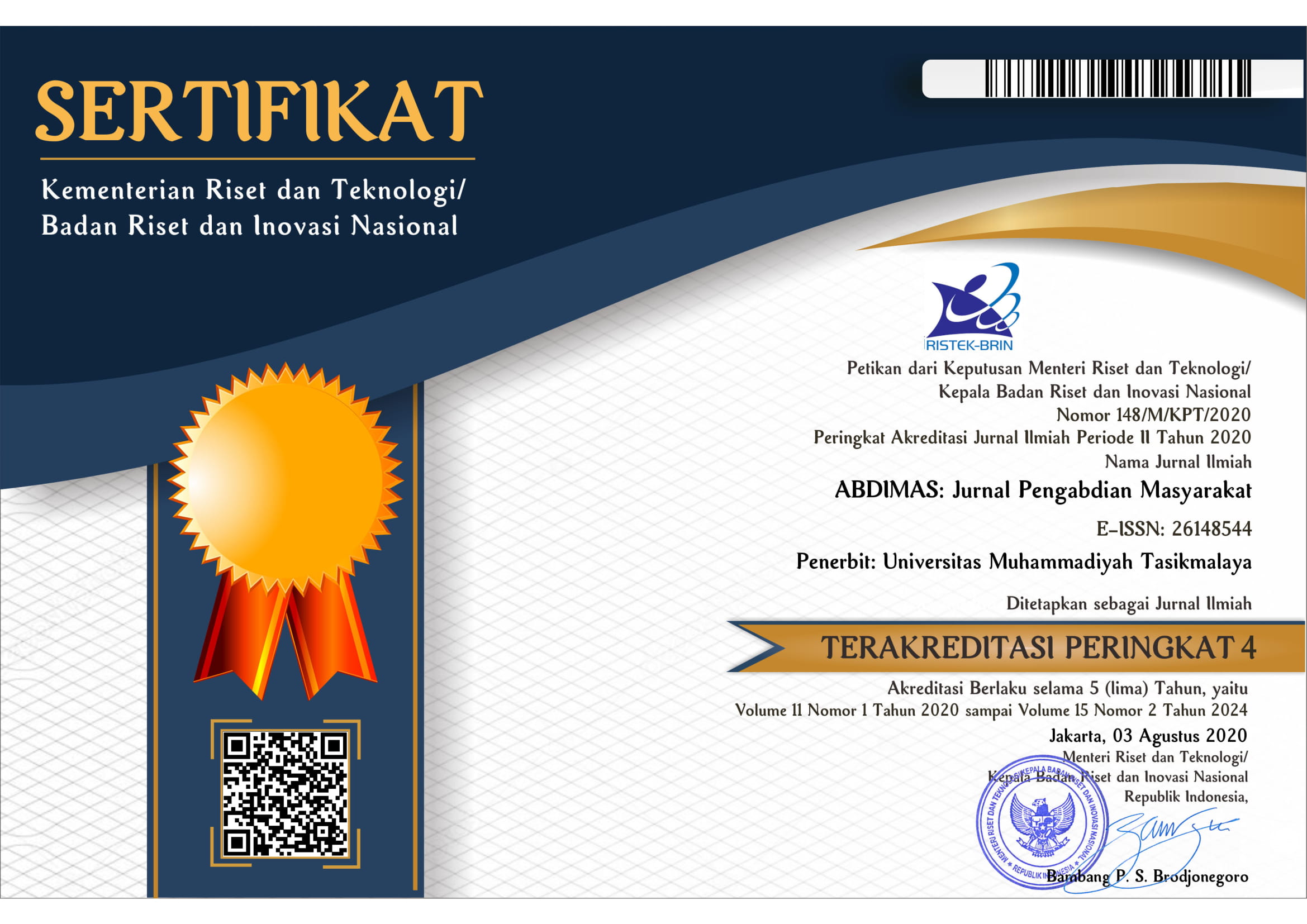Socialization and Workshop of Coding Based on ICD-10 and ICD-9 Cm Regulations at Mental Hospital Prof Hb Saanin Padang
DOI:
https://doi.org/10.35568/abdimas.v7i3.4899Keywords:
ICD-10, ICD-9 CM, RegulationAbstract
Coding based on ICD-10 is assigning codes using letters and numbers representing data components to ensure code accuracy. In coding patient medical actions/procedures, coders use ICD-9 CM rules to assign medical action codes to the patient's resume sheet. The application of coding is used to index disease records, input for medical diagnosis reporting systems, facilitate the process of storing and retrieving data related to diagnosis, characteristics of patients and service providers, basic ingredients in grouping DRGs (diagnostic-related groups) for service fee payment billing systems, national and international reporting morbidity and mortality, tabulation of health service data for the evaluation process of medical service planning, analysis of health service financing, as well as for epidemiological and clinical research. Mental Hospital, Prof HB Saanin Padang is a mental hospital under the government of West Sumatra. To improve the quality of medical recorders and avoid losses in insurance financing claims, the service will carry out Community Service (PKM) activities. This service aims to provide socialization and training on coding diagnoses and actions based on ICD-10 and ICD-9 CM regulations. The PKM activity is a development program where the service team carries out outreach regarding regulations for coding diagnoses and actions based on ICD-10 and ICD-9 CM. Then the team will carry out follow-up activities in the form of ICD-10 and ICD-9 CM coding practices with partners. The partner in this community service activity is the Prof HB Saanin Padang Mental Hospital (RSJ). Based on the topics, several activities consist of socialization of regulations ICD 10 and ICD-9 CM and workshop study case based on ICD 10 and ICD-9 CM regulations. This activity has been done on Mei 07, 2024. Results showed there is increasing knowledge about regulation ICD 10 and ICD-9 CM based on pre-test and post-test results.
Downloads
References
Ainung, N., Wulandari, S., & Widiyoko, A. (2023). Analisis Hubungan Kelengkapan dan Ketepatan Pencatatan Dokumen Rekam Medis Terhadap Keakuratan Kodefikasi Kasus Obstetri di RS PKU Muhammadiyah Surakarta. 3(44), 1–5.
Bowman, E, & Abdelhak, Mervat. (2001). Coding, classification, and reimbursement systems. Health information: management of a strategic resource. 2nd edition. Philadelphia: WB Saunders Company, 229-258.
Eramo, Lisa A. (2012). Don't let fear prevent coders from learning ICD-10.
Ernawati, D.; Kresnowati, L. (2013). Studi Kualitatif tentang Kompetensi Tenaga Koder dalam Proses Reimbursement Berbasis System Case-mix di Beberapa Rumah Sakit yang Melayani er
Hasan, M., R. J. Meara, and B. K. Bhowmick. The Quality of Diagnostic Coding in Cerebrovascular Disease.
Heltiani, N., Asroni, N., & Suryani, T. E. (2023). Analisis Ketepatan Kode Diagnosa Obstetri Terhadap Kelancaran Klaim BPJS Rs . X Kota Bengkulu Analysis Of The Accuracy Of The Obstetrical Diagnosis Code Of The Smoothness Of Claims BPJS RS. X Bengkulu City. 9(1), 1–11.
Ifalahma, Darah. (2013). Hubungan Pengetahuan Coder Dengan Keakuratan Kode Diagnosis Pasien Rawat Inap Jaminan Kesehatan Masyarakat Berdasarkan Icd-10 Di Rsud Simo Boyolali. Jurnal Ilmiah Rekam Medis dan Informatika Kesehatan, INFOKES, VOL. 3 NO. 2 Agustus 2013.
Nuryati, Niko Tesni Saputro. (2015). Faktor Penyebab Ketidaktepatan Kode Diagnosis di Puskesmas Mojolaban Sukoharjo Jawa Tengah. Jurnal Manajemen Informasi Kesehatan Indonesia, ISSN:2337-585X, Vol.3, No.1, Maret 2015.
Parkhi, D., Sampathkumar, S., Weldeselassie, Y., Sukumar, N., Statistik, M., Terbuka, U., & Keynes, M. (2023). Tinjauan sistematis model prediksi skor risiko menggunakan karakteristik ibu dengan dan tanpa biomarker untuk prediksi GDM.
Permenkes RI No. 269/MENKES/PER/III/2008. Tentang Rekam Medis. Jakarta: Indonesia.
Puspaningtyas, C. A., Sangkot, H. S., Akbar, P. S., Dewi, E. S., & Wijaya, A. (2022). Analisis Hubungan Ketepatan Penulisan Diagnosis dengan Keakuratan Kode Diagnosis pada Kasus Obstetri dan Ginekologi di Rumah Sakit Tk. IV DKT Kediri. Jurnal Rekam Medik & Manajemen Informasi Kesehatan, 1(2), 104–110. https://doi.org/10.47134/rmik.v1i2.22
Rustiyanto, Ery. 2010. Statistik Rumah Sakit untuk Pengambilan Keputusan. Yogyakarta: Graha Ilmu
Rohman, H., Setiyawan, & Nugraha, F. B. (2023). Analisis Kelengkapan Dan Ketepatan Kodefikasi Terminologi Medis Obstetri Di Puskesmas Jetis Bantul Yogyakarta. Prosiding Seminar Informasi Kesehatan Nasional (SIKesNas), 72–77.
O'Malley, Kimberly J., Cook, Karon F., Price, Matt D., Wildes, Kimberly Raiford, Hurdle, John F., & Ashton, Carol M. (2005). Measuring Diagnoses: ICD Code Accuracy. Health Services Research, 40(5p2), 1620-1639. doi: 10.1111/j.1475-6773.2005.00444.
Quan, H., G. A. Pearsons, and W. A. Ghali. Validity of Procedure Codes in International Classification of Diseases.














